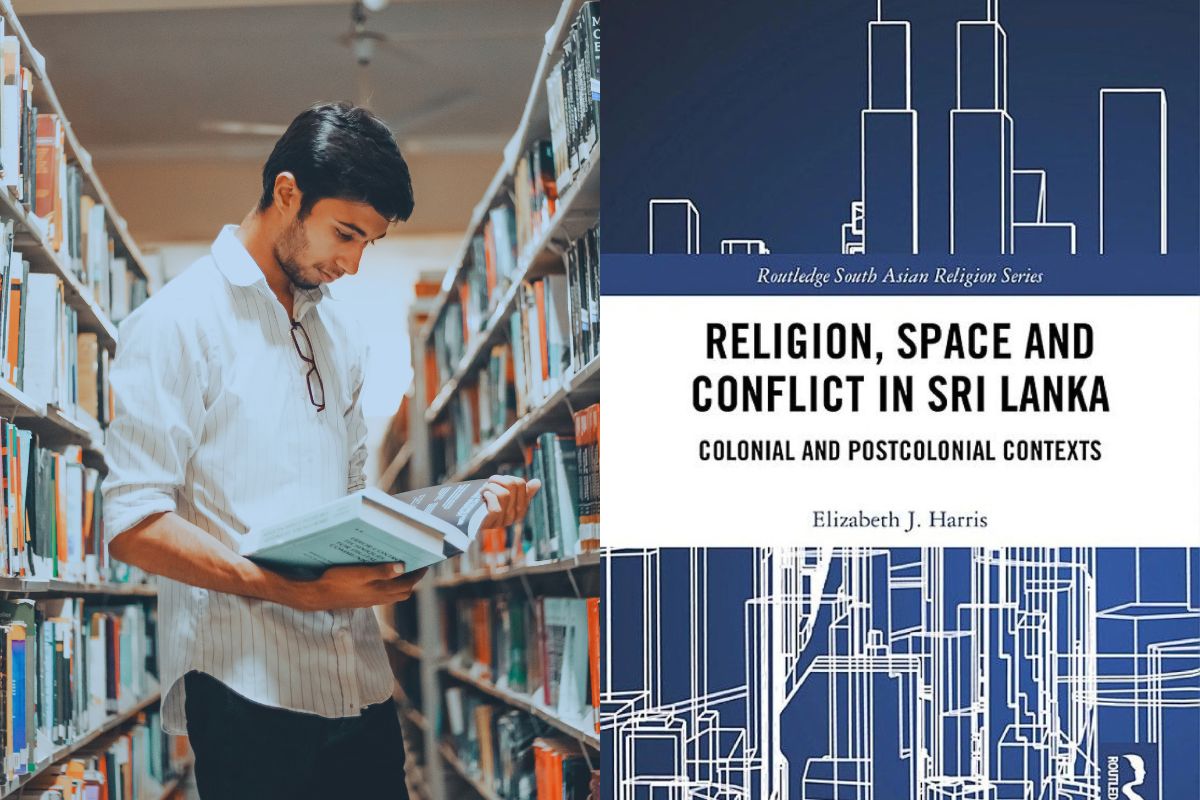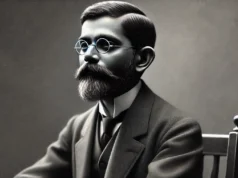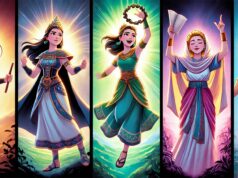
In this book, Harris presents a comprehensive and critical analysis of the changing socio, political and religious situations of the British colonial, Post-Independence and postwar periods in Sri Lanka. Her main analysis is focused on the above eras and she does not address the Portuguese and Dutch periods, which would provide further background to the subject.
The book discusses extensively the Protestant missionaries’ understanding of the demarcation between so-called heathen and Christianized space and the vocabulary used by them. Harris takes an ethno-religious approach in analyzing the situation and provides various practical and theoretical examples concerning the inter-religious and inter-communal conflict of the country.
Furthermore, she vividly expresses the tense situation among the British administrative system, the missionaries and the evangelical Protestant missionary imaginary by bringing in key examples such as the exhibition of the tooth relic for the Thai monastic Sanga (March1843) by the government administration. Governor Hamilton Gordon’s (1890) friendly relationship with Buddhism reveals the hidden tension between Christianity and the colonial administration.
Harris’s findings of invading Buddhist religious practices into the public and government-controlled space and paying a subscription for Buddhist religious affairs was seen as Buddhists encroaching and breaching the Christian territory and emphasized the tense situation between the colonial administrative structure and Christianity.
Harris uncovers the hidden motives and proselytization of the Protestant Christian school system as an approach of inclusivism to exclusivism which uprooted the students from their original culture and traditional roots. Harris argues that this method of education dislocated the child from their native background into the new Christian environment, uprooting them from their native soil.
On the other hand it shows the resistance of the Buddhist children to the proselytization as an opportunity to strengthen their faith in their own religion rather than become subordinated to the new religion. Harris reveals the intra-Christian competition among denominations in opening missionary schools and the Buddhist reaction and defensive steps taken through the starting of Buddhist schools around the country. Mention of the Buddhist Sinhalas revival movement during 1910 to 1920s would have enriched Harris’ argument here.
Harris uses Bishop Copleston’s (1886) views to justify her approach to Buddhist subordinate inclusivism and the Aryan influence of the country. Harris correctly recognizes the creative influence of the Aryan and Dravidian glossary and structures in the Sinhala language; a complex and debatable topic in all eras in relation to Sinhalas identity.
Somehow she uses the physical anthropology approach as the main base to bring out the identity of ethnicity and language as the main fact to be a Sri Lankan. This is fascinating as she brings Coomaraswamy’s understanding of the ‘Aryan’ which denoted the ‘noble spirit’ rather than the ethnic identity which can be more relevant and meaningful in the interpretation concerning the ethnic harmony and reconciliation of the country.
Harris brings into the discussion how Buddhist arts and shrines, Sinhala language and architecture have been used in an inclusive subordination approach by the Sinhala Buddhist community against other minority religious and ethnic communities. I consider that the inclusive subordination approach could be complete if Christianity offered sufficient supermundane level teachings to Buddhism.
Further, Harris brings into the discussion the renovating and reconstruction of ancient Buddhist ruins under British rule which created suspicion and distrust due to the numbers of non-Buddhist and non-Sinhala personnel participating in the working teams. It reveals that the Buddhist consciousness against the non-Sri Lankan and non-Buddhists cooperation in the process of restoring Buddhist archeological places was seen as a threat to the Sinhalas Buddhist heritage.
Further, it is exciting to see that the new land demarcation for the other religious shrines soon after independence in the Anuradhapura and Polonnaruwa Reveals the counter-reaction to colonial Christianity and the Buddhist Sinhala nationalism is highlighted. Harris discusses in depth the Buddhist revivalist movement behind the archeological excavation in Anuradhapura and the opening of Buddhist schools around the country with the leadership of theosophical society; both reveal two different aspects of the Buddhist revivalism.
In the second section of the book, Harris provides a general picture of the post-Independence ethnic war, which has enormously changed the Sri Lankan situation. She brings together a wider range of perspectives and scholarly research about the ethnic war and its background, providing the reader with an overall picture of the problem.
Harris bases her work mainly on Raghavan’s understanding of the ontological insecurity of Sinhalas and the emphasis on inclusivist subordination as the key factors of the problem. She takes into consideration various extreme Sinhala Buddhist nationalistic groups in the recent past who politicized Buddhism in the country, and notes their reactions and ideologies against focusing on Tamil Hindu minority.
Harris doesn’t bring aspects of Tamil nationalism into the discussion, which could provide a more balanced understanding of the ethnic issue. She identified, towards the end of the war, human rights and reconciliation efforts as pro-LTTE or pro-terrorist by the Sinhala Buddhist majority. The services and leadership of the church which was rendered as a religious organization to the Tamil communities during the war and post war eras have been sidelined by Harris.
Harris’ journeys during the war and post-war period to Jaffna and the other places of the country have greatly supported and endorsed her arguments, such as her views concerning the inclusive subordination approach of Sinhalas Buddhist nationalism. She has provided various photographs which she took during her visits to North, East, and Vanni after the war.
These pictures provide sufficient illustration to the reader regarding the post-war context of the country. These pictures advocate the understanding of the expansion of Buddhist space in the North and East provinces which was barely debated or challenged even by the intermediating groups or the peacemaking international institutions.
Her interviews from these visits bring out the genuine grievances and pain of the Tamil speaking community in these areas, which have hardly come into the public domain. Therefore by providing the facts of Buddhist religious expansion in Northern and Eastern provinces, she has helped raise the concerns of an often voiceless community in Northern and Eastern provinces. On some occasions, she provides examples of religious co-existence in Northern Province which goes back to before the ethnic war which has been forgotten by many and she traces the historical and religious value of the sites.
Often she identifies the religious shrines as places of division rather than sacred ground which have been important in creating unity among communities. This demonstrates that religion has been politicized and linked to exclusive ethnicity identity rather than being an instrument to build harmony among ethnic communities.
Harris portrays various examples concerning the Hindu shrines to show that the Sinhalas lack of awareness of the Tamil people’s life and culture has a direct connection to ethnic tensions. Using Perera’s understanding of ‘War Tourism’ Harris identifies it as another manifestation of war, the victorious mindset of the southern people which has brought considerable negative and defeated feelings in Tamils in the North and East. If she had analyzed the consequences of the Tamil consensuses regarding this, it would have been much better and it may have revealed the complex feelings of the Tamil victims.
Harris correctly discerned the mass consciousness against the politicians’ agenda on the ethnic war and correctly critiqued the minds of the politicians. She mentioned as her final remark, the Sinhalas isolationism from the rest of the world or ontological insecurity supplying profound answers to the escalation of the ethnic conflict of the country.
Therefore this book will direct new ways of thinking and analyzing the questions in relation to the ethnic and religious identities in the Sri Lankan context and beyond. Therefore it motivates others to think and to engage in new research as the book opens more queries in the readers’ mind.
Revd. B. Leslie Dareeju is from Sri Lanka and a PhD candidate at VU University, Amsterdam
Read Other Articles by Rev Dr Leslie Dareeju
Jesus Healing the Paralytic









